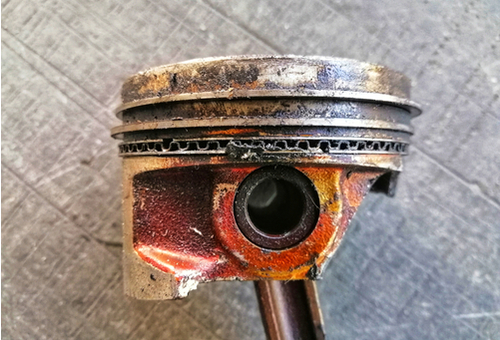
The root causes of piston and cylinder liner failures caused by issues other than outright fractures can sometimes be very difficult to determine due to the scale of the damage on the affected pistons. In many cases, the damage “smears” out evidence of the start of the problem, so if the entire wear surface of a piston is covered with seizure marks, it can often be difficult to tell if the problem originated in insufficient clearances, a lack of proper lubrication, or with abnormal combustion over an extended period.
In contrast to this, however, the cause(s) of outright fractures in modern diesel piston designs are for the most part, much more clear-cut, and sometimes, much can be learned from the appearance of the surfaces of the fracture faces. Thus, in this article, we will discuss some of the principal causes of diesel piston fractures, as well as provide some information on what to look for when you are diagnosing piston fractures in diesel engines. Let us start with asking this question-
In practice, engine failures caused by piston fractures are far less common than engine failures caused by excessive mechanical wear and/or piston seizures. Nonetheless, given the sheer number of passenger cars on the roads of the world today*, it is not unreasonable to assume that every working mechanic in the world today will see at least two or three instances of engine failure caused by piston fractures in his or her working life. This is true even if a minority of modern passenger cars is diesel-powered.
*Estimates on the number of passenger vehicles in the world vary by huge margins. Depending on the source(s) consulted, the number of passenger vehicles in the world today range from about 1.1 billion, to about 1.4 billion. It is of some interest to note that the number of passenger vehicles in use around the world exceeded one billion for the first time in 2010.
On the face of it, the large number of engine designs and types that propel the international car parc would suggest a large range of possible causes of piston fractures. However, while wildly different operating environments and servicing regimes partly account for the observed disparities in the prevalence of piston fractures between major automotive markets, the fact is that pistons break for largely similar reasons, and in much the same way, the world over.
In a practical sense, pistons in modern diesel engines break or fracture for only two reasons, these reasons being metal fatigue and/or severe or repeated impact forces. Let us look at each in turn-
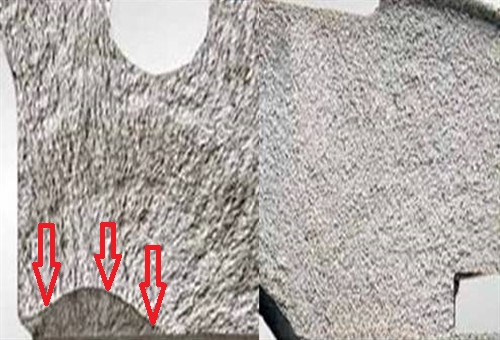
Image source: https://www.memoparts.com/img/cms/Documents/Piston%20Failue.pdf
This panel shows examples of the two types of fracture. Let us look at each in turn-
This type of fracture always starts at the point where the mechanical overload of the material is the highest. In this example, the nodal line, which is the line marked out with the arrows, started in the gudgeon pin bore and progressed outward from that point. In these types of fractures, the surfaces of the fractured material can show a kind of "fan" pattern as shown here, or the surfaces can be worn smooth as a result of the relative motion between the parts rubbing the surfaces smooth before the separation occurs.
In pistons, these types of fractures usually occur as the result of knocking caused by abnormal combustion, mechanical contact between the piston crown and the cylinder head for whatever reason, on in some cases, by severe vibrations in the piston caused by excessive piston skirt to cylinder wall clearances. Less common causes of this type of fracture include overstressing of the gudgeon pin boss by bent, distorted, or misaligned connecting rods.
The example on the right of the panel shows an example of an impact fracture. These types of fracture only occur as the result of a) a foreign object affecting the piston crown repeatedly, or the piston crown slamming into the cylinder head.
Note the different appearances of the fracture surfaces. In this representative example, there is no rubbing, and no progression of a crack: in these cases, the piston breaks or disintegrates suddenly, and often, explosively. Consider the image below, in which the two types of fracture shown in the panel above are placed into the context of both (fracture) types contributing to the failure of the piston-
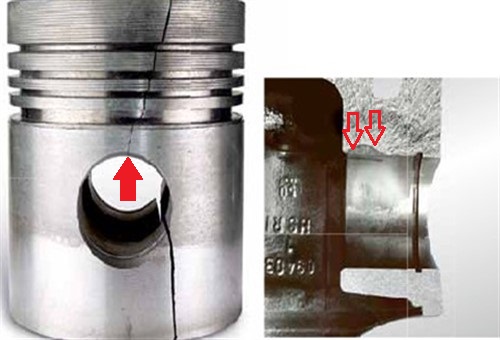
Image source: https://www.memoparts.com/img/cms/Documents/Piston%20Failue.pdf
This image shows the two fracture types in the context of a single piston. Here, the solid red arrow indicates the point of origin of the crack that progressed through the ring zone and into the piston crown. This crack progressed to the point where the piston had lost its rigidity, which caused the repeated impacts between the piston skirt and the cylinder wall that, in turn, caused the piston to break into two pieces along the fracture line.
Note, however, that while it is common to see both fracture types on a single piston at the same time, one fracture type always occurs first, which then induces the other fracture type. In practice, though, this type of scenario is typically caused by one or more of the following issues-
Note that the kind of piston fractures discussed above can occur on diesel engines that are new, old and well run-in, as well as newly rebuilt or reconditioned. However, piston fractures as the result of mechanical contact between piston crowns and the cylinder head(s) are arguably among the most common causes of diesel engine failure soon after a rebuild or extensive reconditioning. With that said, let us look at-
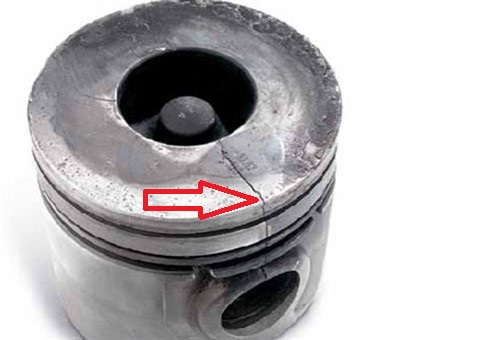
Image source:https://www.memoparts.com/img/cms/Documents/Piston%20Failue.pdf
In this example, the shiny area on the piston crown is where the contact occurred, but note that in this example, the area is too wide for a possibly unsuitable head gasket to have been the cause. The impact area is also localised, meaning that the most likely cause of this failure was an excessive build-up of carbon on the valves or the piston crown.
Nonetheless, in this case, the red arrow indicates the point where the crack started, which was where the piston was the weakest, i.e., directly above the centre of the gudgeon pin bore. In practice, once the crack started it followed the path of least resistance (as defined by the distance between the edge of the piston and the centre of the gudgeon pin bore), and as might be expected, it terminated at the weakest point on the gudgeon pin boss, as shown by the red arrow in the image below-
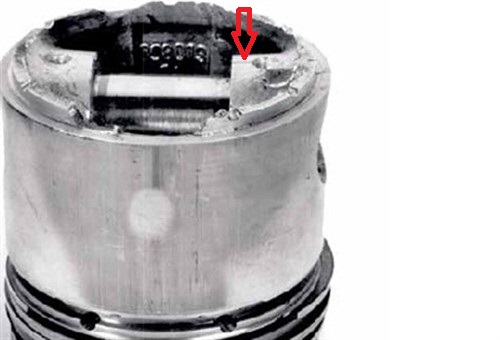
Image source: https://www.memoparts.com/img/cms/Documents/Piston%20Failue.pdf
In this case, the crack also destroyed the rigidity of the gudgeon boss and because the cyclical impacts on the piston crown induced severe vibrations in the piston, a fatigue fracture occurred in the lower oil ring groove, which was the next weakest point in the structure of the piston. In this example, the entire piston skirt broke off in one piece, as might be expected with a fatigue fracture around the weakest point of the piston skirt.
This type of failure can potentially damage, bend, or even destroy the connecting rods, crankshaft and cylinder liners in engines that are fitted with cylinder liners. Therefore, it is important to be aware of-
Before we look at some specifics, it is important to remember that of all critical dimensions on diesel engines, the compression height of the pistons is among the most critical. This height determines the terminal clearances between the highest point of the pistons and the lowest points of the cylinder head and/or the valves when they are in the open position.
However, while getting this dimension marginally wrong by fitting the wrong pistons or cylinder head gasket(s) during a rebuild might only result in somewhat excessive compression or incomplete combustion, getting it seriously wrong can destroy the engine.
In short, the importance of maintaining the correct compression height in a diesel engine cannot be overstated, but with that said, let us look at some specifics-
Worn crankshaft bearings and/or small end bushes
As a practical matter, it is possible to have marginally or even moderately worn-out crankshaft bearings on a diesel engine without being aware of that fact. Since big-end bearings on diesel engines are very wide, excessive clearances are, for the most part, absorbed by the film of lubricating oil in the bearing interface. Provided the oil pressure is within specifications, the large diameter and width of diesel big-end bearings combine to provide a large surface area that largely masks the effects of moderately excessive clearances.
As a result of this, most diesel engines will not only not exhibit any of the characteristic noises and sounds that worn bearings give off in a petrol engine, but most diesel engines with moderately worn bearings worn will also perform satisfactorily for many years provided they are not suddenly driven aggressively.
So if the crankshaft bearings are moderately worn, and the engine is suddenly subjected to higher speeds than it usually sees, such as might happen when descending a hill in the wrong gear, the higher speeds and increased kinetic energy of the pistons can displace the thicker-than-normal oil film from the large clearances in the bearing interfaces. This does not only create boundary lubrication conditions, but it also makes the piston travel further upward, and in a large engine, this added travel distance can drive the pistons into the valves or the cylinder head.
Installation of incorrect/unsuitable pistons
One common practice when people are having their diesel engines rebuilt is to have the sealing surface on the engine block "decked" or skimmed to ensure the surface is flat, and often in addition to having the cylinder head skimmed to ensure flatness.
On petrol engines, this is rarely an issue, but on diesel engines, having both surfaces machined will inevitably reduce the “gap dimension", which is the free space between the piston crown and the cylinder head, to fall below a minimum allowable limit. This distance varies between engines, but the point is that unless either an oversize head gasket or pistons with reduced compression heights are fitted to an excessively machined diesel engine, the pistons will contact either the valves or the cylinder head.
The problem is that while all competent professional engine rebuilders know this, most non-professional engine rebuilders or DIY car enthusiasts do not. Thus, when you are diagnosing an engine with impact-fractured pistons, the first thing to do is to-
In practice, all major manufacturers of high-quality aftermarket engine parts supply both head gaskets and pistons for diesel engines that are designed specifically to compensate for both a reduced cylinder head thickness and reduced cylinder lengths caused by "decking" the block. Bear in mind that when it comes to compression heights and gap dimensions on diesel engines, “close enough” is never good enough; deviating from specified values by as little as two-tenths of a millimetre is often enough to destroy a newly-rebuilt diesel engine.
SPECIAL NOTE: It is both common and good practice to turn an engine by hand after each step in the assembly process to ensure that nothing binds, sticks, or interferes with anything else. However, this is often not enough to ensure or guarantee that the pistons on a rebuilt diesel engine will not strike the valves or the cylinder head(s) almost as soon as the engine enters service- even if the engine is turned freely by hand before it entered service.
As stated elsewhere, the gap dimension is by far the most critical dimension on any diesel engine. Therefore, even if a cylinder head gasket is marginally undersized, and/or the compression height on the pistons are marginally too high, the engine might still turn freely by hand when it is cold.
However, when the engine heats up, both the pistons and connecting rods expand lengthwise, and in large commercial engines and some high-performance diesel engines, this expansion can add several tenths of a millimetre to the combined length of the piston/connecting rod assembly.
We have said this before, but it bears repeating: the gap dimensions in diesel engines are exceedingly small. Therefore, when you are trying to figure out why the pistons on a diesel engine contacted the cylinder head(s) and/or valves, you must consider factors like (possible) excessive machining of sealing surfaces, and/or the use of incorrect gaskets and/or pistons. If you fail to take proper account of these factors, you might never reach a valid conclusion on the root cause of the engine failure, which leaves us with-
While the few possible causes of piston fractures on diesel engines we discussed here represent only the tip of the proverbial iceberg, the issues we discussed here are arguably the most common causes of piston fractures on modern diesel engines.
In a follow-up article, we will conclude this current series of articles by discussing other, and perhaps more exotic causes of piston fractures. These include gudgeon pin failures, gudgeon pin circlip failures, piston ring fractures that progress into piston fractures, abnormal combustion processes that cause combustion bowls to crack, and gudgeon pins seizing in their bores.